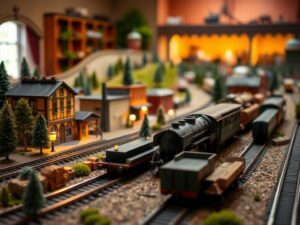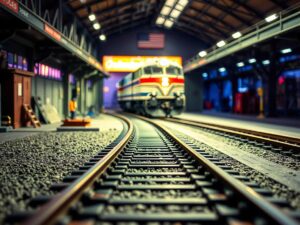How to Control Turnouts and Signals with DCC
How to Control Turnouts and Signals with DCC
How to Control Turnouts and Signals with DCC
Welcome, fellow railroad enthusiasts! Today, we’re diving into the fascinating world of DCC turnout and signal control, a game-changer for any HO scale model railway. No more tedious manual flipping or confusing block systems â imagine seamlessly controlling your turnouts (switches) and signals directly from a central console, automating complex train movements with precision and elegance!
Let’s break down this exciting aspect of DCC operation and explore the hows and whys behind it all.
Understanding the Power of DCC Control
Before we get into the specifics, let’s understand what makes Digital Command Control (DCC) so powerful for turnout and signal management. In essence, DCC sends individual coded signals to each locomotive, allowing you to control speed, direction, and more â but its real magic lies in its ability to manage accessory devices like turnouts and signals.
With traditional DC operation, controlling accessories usually involved wires connected directly to specific switches or resistors. This method is limited in terms of complexity and automation. DCC, however, allows us to wire turnouts and signals to a central control system (think your command station) where they can be activated individually, grouped together for complex scenarios, and even controlled via programming and sound decoders.
Digital Turnout Wiring: Simplified Explained
DCC turnout wiring involves using a specialized piece of electronic circuitry known as a turnout motor or “DCC-compatible turnout.” These motors receive the DCC commands and move the switch mechanism precisely, ensuring smooth transitions between track configurations.
-
Common Components: You’ll typically need wires to connect the turnout motor to your command station and power source, along with additional jumpers for setting the direction of throw (normal or reversed)
- Power Wiring: Power from your DCC system should always flow through a designated accessory output bus on your command station.
-
DCC Turnout Circuit: The specific wiring connections may vary depending on the manufacturer of your turnout motor, so always consult their instructions carefully!
Let’s Talk About Signals: DCC-Managed Visibility
Just like turnouts, signals benefit tremendously from DCC control. We can program individual lights or arrays to represent different signal indications â green for “clear,” yellow for caution, red for “stop” â enhancing realism and providing clear instructions for your trains.
-
Types of DCC Signals: You have several options for DCC-managed signals:
-
Pre-Programmed Signal Boards: These boards offer pre-set lighting configurations controlled through the command station.
- Custom LED Lighting Panels: Use LEDs in conjunction with electronic controllers (e.g., a digital signal controller) for intricate signal layouts and animations.
-
DCC Accessory Control Decoders: Your Command Center Hub
DCC accessory decoders are crucial components for streamlining turnout and signal control. These little devices connect to your command station and can be programmed to activate specific accessories, creating automated sequences and eliminating the need for constant manual adjustments.
Here’s a simple example: You want to program a scenario where a red signal turns to yellow when a train approaches. The accessory decoder would receive that command from the DCC system, trigger the change in signal color, and potentially even initiate other actions like closing a turnout or triggering a sound effect on your locomotives.
Tips and Tricks for DCC Enthusiasts:
-
Plan Your Layout Ahead: Think about how turnouts and signals will be integrated into your layout before you begin wiring. This helps with organization and efficient space utilization.
- Start Simple, Expand Gradually: Begin with a few key turnouts and signals and gradually incorporate more as you become comfortable with the DCC system.
-
Experiment and Have Fun!: The beauty of DCC is its flexibility. Don’t be afraid to experiment with different control options and sequences.
Useful Insights for Your DCC Journey:
-
DCC Turnout Wiring Kits: Several manufacturers offer convenient DCC turnout wiring kits, providing pre-cut wires, connectors, and instructions tailored to specific turnouts.
-
DCC Software Tools: Explore specialized DCC software programs that can simplify signal programming and automate complex scenarios.
Remember, fellow model railroad enthusiasts, mastering DCC turnout and signal control takes time and practice. But the results â smoother, more realistic, and utterly immersive train operations â are worth every step! Don’t hesitate to ask questions, join online forums, and learn from other hobbyists on your journey towards DCC excellence!




